May 2, 2022 | Uncategorized
The work that we do as scientists and engineers is made more meaningful when we are connected to the problem we are trying to solve. I realized early on in my graduate school career that there is a major difference between an idea that has intellectual and academic merit and one that addresses a real societal need. I identified entrepreneurship as a way of having far-reaching impact by connecting real societal needs with promising and fascinating scientific innovations.
The New Venture Development program, organized by the Office of Entrepreneurship and Innovation, has been a highly rewarding outlet for me to explore this process. As a part of this program, MBA students are paired with students pursuing the Graduate Certificate of Entrepreneurship, and the program is designed to give participants practical and hands on experience developing a viable business model for promising ideas and innovations.
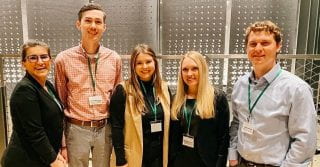
In August of 2021, I joined a team of scientists and business professionals to develop CiphrX Biotechnologies, a startup that addresses the current limitations of brain cancer diagnosis. In addition to myself, the founding team consists of Hailey Carter, Drake Harrison, Dr. Stephanie Gannon, and Dr. Emilie Darrigues. Hailey is an Executive MBA (EMBA) student with healthcare startup experience and Drake is also an EMBA student with 6 years corporate experience with JB Hunt and serves as a National Account Executive. Stephanie recently graduated with a Ph.D. in Neuroscience and now works in Emerging Technology at Walmart. My journey in this program ultimately began when I met Dr. Emilie Darrigues, a post-doctoral fellow in the department of Neurosurgery who is advised by Dr. Analiz Rodriguez, Director of Neurosurgical Oncology at UAMS. Dr. Rodriguez is an inventor on the patent-pending technology, and CiphrX has leveraged this piece of technology to develop a diagnostic workflow that improves upon the current standard of diagnosis for brain cancer. 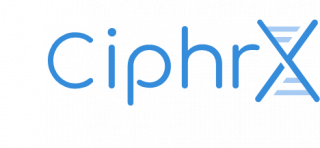 300,000 people are diagnosed with a brain tumor in the United States every year, and it takes up to six weeks to confirm a diagnosis after receiving a tumor biopsy. This time delay is largely due to the World Health Organization guidelines, which recommends genetic sequencing as part of standard diagnosis. As a result, tumor samples are sent to an external sequencing company, resulting in a prolonged and distressing wait for patients and their families. CiphrX provides a solution that enables same-day genetic sequencing to be performed within the hospital, ultimately accelerating the initiation of treatment and enabling enrollment into potentially lifesaving clinical trials. We leverage a third-party Oxford Nanopore sequencing device and our product consists of a patent-pending sample preparation kit that enables rapid sample preparation using a CRISPR-based enrichment approach. Additionally, CiphrX provides a proprietary software platform that analyzes the data and produces a user-friendly report to guide clinical decision-making. I was drawn to this idea early on because of its relevance to my own research in the lab of Dr. Chris Nelson (Department of Biomedical Engineering), exploring the application of Oxford Nanopore sequencing to characterize the precision and efficacy of CRISPR-Cas9 gene editing.
300,000 people are diagnosed with a brain tumor in the United States every year, and it takes up to six weeks to confirm a diagnosis after receiving a tumor biopsy. This time delay is largely due to the World Health Organization guidelines, which recommends genetic sequencing as part of standard diagnosis. As a result, tumor samples are sent to an external sequencing company, resulting in a prolonged and distressing wait for patients and their families. CiphrX provides a solution that enables same-day genetic sequencing to be performed within the hospital, ultimately accelerating the initiation of treatment and enabling enrollment into potentially lifesaving clinical trials. We leverage a third-party Oxford Nanopore sequencing device and our product consists of a patent-pending sample preparation kit that enables rapid sample preparation using a CRISPR-based enrichment approach. Additionally, CiphrX provides a proprietary software platform that analyzes the data and produces a user-friendly report to guide clinical decision-making. I was drawn to this idea early on because of its relevance to my own research in the lab of Dr. Chris Nelson (Department of Biomedical Engineering), exploring the application of Oxford Nanopore sequencing to characterize the precision and efficacy of CRISPR-Cas9 gene editing.
We conducted over 45 customer discovery interviews in the Fall semester, focusing on key stakeholders such as neurosurgeons, hospital administrators, and pathologists. Based on our validated business model, we competed in four business plan competitions over the Spring semester. Most notably, we were the only Arkansas team to make it to the final round of the Heartland Challenge and ultimately placed 4th overall as well as 2nd place in the Elevator Pitch. We also placed 2nd in the Arkansas Governor’s Cup competition. The business competition circuit was definitely the highlight of this program and was an incredible opportunity to network with and receive feedback from highly established entrepreneurs and investors. The mentor network that the Office of Entrepreneurship and Innovation has built is vast and one of the more exciting aspects of the program. As participants in the Heartland Challenge, we heard from and were able to meet highly successful entrepreneurs and investors like Alice Walton, Jim Goetz, and Steve Nelson.
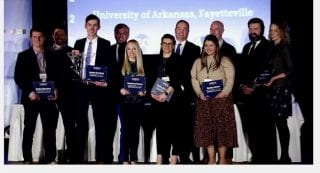
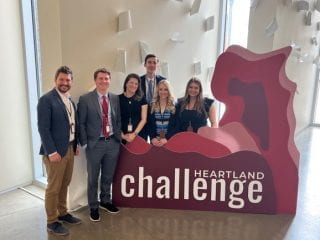
As I reflect on my experience in this program, I am left with a greater understanding of the importance of engineers and scientists leaving the laboratory to meaningfully connect with the problem that is being addressed. I also recognize the value of collaboration across multiple disciplines and being able to communicate technically complex ideas to unfamiliar and non-scientific audiences. The value of pursuing something that makes you uncomfortable initially should not be underestimated. It is not my natural instinct to get up in front of hundreds of people, but I quickly became the designated “elevator pitcher” for our team and used this as an opportunity to grow and communicate more effectively. I also learned that who you choose to surround yourself with is crucially important, and a great team with great mentors makes all the difference. Northwest Arkansas is a great place to grow a business and this program has highlighted the wealth of opportunities available to budding entrepreneurs and growing businesses. I am very appreciative of the work of Sarah Goforth and David Hinton, who have designed such an impactful program and been excellent mentors to CiphrX. I am excited to take my learnings from this program and apply it in a meaningful way.
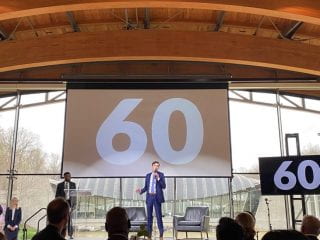
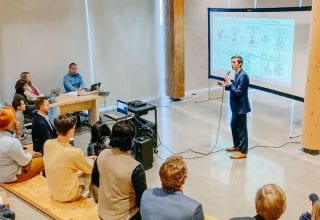
By: Landon Burcham
MS Student, Department of Biomedical Engineering
Graduate Fellow, Office of Entrepreneurship and Innovation
Apr 20, 2022 | BMES
A week before the College of Engineering’s 2nd annual, “Eggs-Travaganza Hallway Hunt,” scheduled for Thursday, April 14th, nearly 20 Biomedical Engineering Society (BMES) students joined Biomedical Engineering staff members Cassandra Parks and Austin Blevins in putting together special BMEG eggs for the department’s portion of the egg hunt.
“We had a lot of fun, and it went faster than I thought it would,” said Cassandra Parks, BMEG’s fiscal support manager. “We listened to music and finished putting the eggs together quickly because we had so many students help thanks to Fah Sysavanh.” Sysavanh is a senior BMEG student and president of BMES. Young Hye Song is the faculty advisor for the organization.
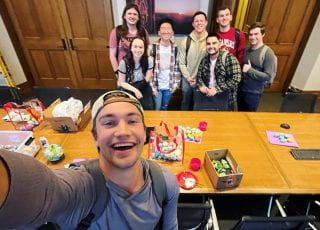
BMES students assembled sustainable Easter eggs
The hunt, hosted by COE’s First Year Program, is a project to increase student retention and familiarize students with the various COE departments. Most departments are using plastic eggs and adding a piece of candy to each one for students to find throughout the engineering buildings, Bell and White Hall.
BMEG staff wanted to take the project a step further, and with BMEG department head Raj Rao’s approval and support, decided to reuse the department’s shredded paper to create paper eggs for the event. Also, instead of candy, staff wanted to provide more substantial prizes.
Over 125 eggs were put together, each holding a strip of paper informing students of the prize they had received. Prizes included BMEG t-shirts, stress Hogs, and special prizes created by staff and family members. Parks crocheted sets of egg-shaped coasters. Piper Hart, a senior U of A art student, made ceramic eggs, and her father, Gene Hart, made sets of ceramic egg-shaped coasters. The Harts are family members of Peg Hart, BMEG’s grants coordinator. Hart made the paper eggs used in the project.
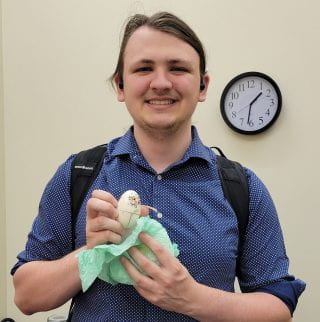
BMEG Student Daniel Maxenberger
“I am excited about our staff thinking outside the box to come up with this creative spin on the egg hunt,” said Rao. “When we get involved in a student project, we want to make it a special experience for students. I think this is another success.”
Story by BMEG’s Fiscal Guru Cassandra Parks
Apr 13, 2022 | Uncategorized
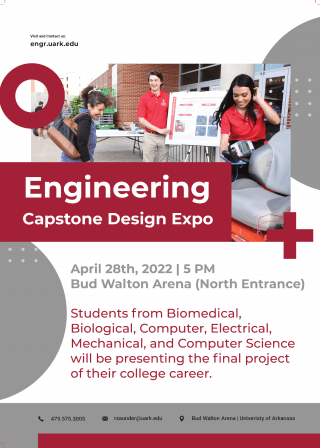
Apr 13, 2022 | Uncategorized
Being a part of the National Society of Black Engineers (NSBE) has provided me with a safe space while on my journey to completing my degree. I knew that being a minority in the STEM field would come with its challenges, but the burden is easier to carry when you have a supportive network of people encouraging you along the way. Overall, NSBE is one of the largest student-governed organizations based in the United States; there are over 600 chapters in the country! NSBE’s mission is “to increase the number of culturally responsible Black engineers who excel academically, succeed professionally and positively impact the community”.
Attending the National NSBE Convention in Anaheim, CA was an amazing opportunity for me to network with other engineers in the field, especially with people who looked like me. The 4-day conference consisted of workshops, social events, a 2-day career and graduate school fair, and design competitions. I was able to meet people from all areas of the country to hear about their experience as engineers and engineering students and learn about future opportunities within STEM. I learned how flexible an engineering degree can be and how I could shape my future career based on my personal goals and interests. There was also an abundance of information about job opportunities, special topics within science, graduate schools, and workshops on research grants.
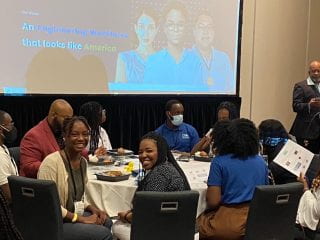
(Photos – Left: Breanna Kilgore on the 1st day of the conference, Right: Breanna and Kaitlin attending a NACME Scholar Networking Lunch)
As someone who desires to attend graduate school, I was able to attend Q&A sessions from women in the field who have obtained their PhD and currently work in the engineering field. It was inspiring to see women, especially Black women, preserve through the challenges within STEM that come along with being a minority. This was my favorite part about attending the conference – feeling inspired by the ones who have come before me. Everyone there was able to share their story and encourage all students to remain resilient on their journey. My favorite aspect of the convention were the many opportunities and connections I made with other Black women who were currently working in the medical device field, which is something I desire to pursue in the future.
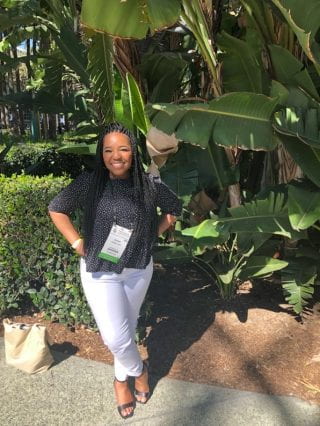
Senior BMEG student, Kaitlin Hall, shares her favorite part of the convention:
“My favorite part of the NSBE conference was the carnival because although everyone was attending for professional purposes, the carnival gave us the opportunity to have fun and enjoy our culture. Personally, I went to the conference in hopes of making new connections with different companies in order to obtain a job or internship. I’m proud to say that I was successful and even gained a couple interviews! I would advise anyone looking to expand their connections or just wanting to meet wonderful people to go the next NSBE conference.”
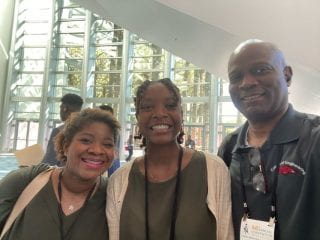
I strongly recommend for all students to attend some type of engineering conference, especially if they cater to specific affinity groups such as Society of Women in Engineering (SWE), Society of Hispanic Professional Engineers (SHPE), and major specific groups (Biomedical, Electrical, Civil, etc.). Conventions like the National NSBE Conference give students the opportunity to display their talent, discover career pathways, socialize with peers, and the chance to meet the experts in their field. I extend my gratitude to Thomas Carter III, the college NSBE Chapter, and the College of Engineering for the opportunity to travel and participate in this conference!
Sep 3, 2021 | Uncategorized
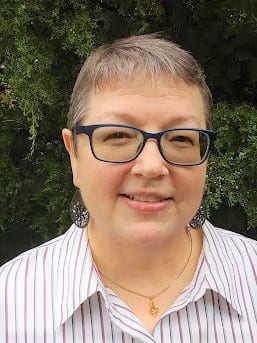 The week of Aug 30 – September 2, I attended the National Council of University Research Administrators’ (NCURA) 63rd Annual Meeting. The conference, held in Washington DC, was a hybrid meeting with virtual and in-person attendees. Over 1,250 individuals attended, five representing the University of Arkansas.
The week of Aug 30 – September 2, I attended the National Council of University Research Administrators’ (NCURA) 63rd Annual Meeting. The conference, held in Washington DC, was a hybrid meeting with virtual and in-person attendees. Over 1,250 individuals attended, five representing the University of Arkansas.
The theme was “Reconnect,” as this was the first in-person annual conference since the COVID pandemic occurred and most people worked from home for the last year and a half. Throughout the conference, communicating and connecting with others were stressed.
I didn’t know exactly what to expect from attending virtually, but the home screen was setup like a lobby entrance with banners I could select to go to the exhibit hall, attend sessions, check out networking, or get tech support. Since it was point-and-click, it was a very user-friendly format.
The session choices were on a wide range of topics, all of which had different relevance depending on an attendees’ needs. Of course, there were more sessions than I could possibly attend, but we were given access to handouts to all sessions so I was able to gather information on different topics that I can review later. If some sessions weren’t relevant to me, there were plenty of others from which I could choose.
Although many of the sessions were prerecorded, each was followed by a live Q&A portion via Zoom. The chat rooms stayed busy with follow-up questions and insightful comments. I started out with sessions that provided updates to NSF and NIH guidelines and ended with the future of hybrid and remote work. By the way, if you didn’t already know, it looks like hybrid and remote work are here to stay!
One of my favorite sessions discussed a study at Oklahoma State University in which tenured and tenure-track faculty in STEM and non-STEM areas were asked about their perceptions of grant development and the purpose of grant funding. Six main purposes stood out, including providing mentoring to graduate and undergraduate students (research training). This point caught my attention because it is such an important part of our department’s goals.
I appreciate Dr. Rao giving me the opportunity to attend this conference to gather information which I believe will assist me as we move forward to a new year of grant proposals. Who knows, maybe one day I’ll be presenting information about our success at an NCURA meeting!
Jul 7, 2021 | Uncategorized
What is the Alpha Research Program?
The Alpha Research Program was designed by Alexis Applequist, a University of Arkansas (U of A) biomedical engineering (BMEG) undergraduate, and Bladen Ketron, a U of A marketing undergraduate. It was set up and launched through the U of A Biomedical Engineering Society with the help of BMEG undergraduates, Ashley Fernandez and Smit Patel. This program is an opportunity for any undergraduate at the U of A to engage in research regardless of experience level. Spring 2021 was the first active semester of the program.
Why was the program created?
A large need exists for more research positions outside of general classwork in the college of engineering. While formal university labs offer a hands-on approach to research and learning in state-of the art labs, the positions available are scarce due to funding and available training. For example, in 2018, one BMEG university lab received 32 applications, interviewed 16 undergraduates, and accepted only four into the lab. Clearly, the demand for undergraduate research positions far exceeds the supply. University labs also typically require a certain number of hours per week researching. Due to students’ busy academic and extracurricular schedules, many are turned off from research because of these taxing requirements. Overall, formal labs and the Alpha Research Program offer students experience with lab equipment and software, real-world applications of class content, networking opportunities, interdisciplinary collaboration, and further exploration of current topics of interest in the BMEG field, and should be available to all undergraduates.
How does the program work?
Each semester, students indicate their research fields’ interests within the department of biomedical engineering (i.e. tissue, cardiovascular, and genetic engineering). Mentors, individuals with extensive research experience willing to graciously donate time to the program, are gathered from different fields: industry professionals, UARK professors (BMEG and other fields of study), and graduate students. Each research team consists of four to six student researchers and one mentor to guide their research journey. The current Alpha program does not perform wet-lab activities, rather, teams work to develop computer models through coding and innovate new biomedical devices and services. There are no minimum hour requirements, but researchers are asked to track their hours in a log for personal use. Each group presents during a full lab meeting halfway through the semester. The end of each academic year wraps up with a Research Poster Symposium. This is an opportunity for each group to design a poster and present its work to colleagues, friends, and family.
What does the future hold for the program?
Biomedical Engineering Society (BMES) leaders of the Alpha Research Program are working with the U of A department of biomedical engineering to offer optional credit for students’ research as a BMEG elective in the future. It is a possibility that honors theses may also be based on this research. The program is exploring presenting posters within the BMEG department annual undergraduate research poster symposium. Possible entries into the BMES Annual Conference are also an opportunity for future groups.
What about the members’ experiences?
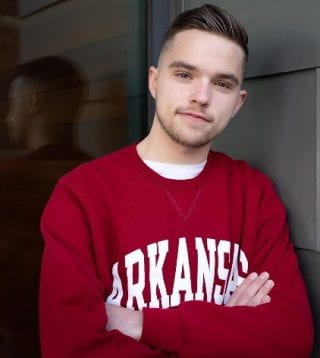 Nick Burdolski, researcher, first-year U of A Biomedical Engineering Nick Burdolski, researcher, first-year U of A Biomedical Engineering |
“…the program is excellent. It has offered me an opportunity to get involved with meaningful research at the beginning of my college career and has allowed me to work with and make connections with fantastic mentors. It has opened doors for me that will allow me to continue to succeed in the future… Working with Dr. Ingels has been great, he is a fantastic mentor. I’ve been in contact with him and Dr. Jensen, and I may be joining the Mitral Valve project [in Dr. Jensen’s university lab] next year which I am really looking forward to!” |
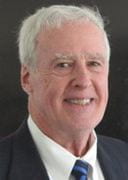 Dr. Neil Ingels, mentor, U of A Biomedical Engineering Adjunct Professor Dr. Neil Ingels, mentor, U of A Biomedical Engineering Adjunct Professor |
“This BMES program has been a success. We meet regularly and have worked on the challenging problem of monitoring persons who are living alone so that loved ones can be notified and take action (call, notify neighbors, etc.) if the person living alone has not moved in their home for the past several hours (and thus could possibly be in distress). We have developed a working prototype that has increased our knowledge of Arduino computer hardware and C++ programming, passive infrared sensing, WiFi connectivity, IFTTT/Webhooks-triggered messaging, and statistical pattern recognition. This project provides a real-world application that ties together a number of concepts that are taught more abstractly in important Biomedical Engineering courses.“ |
 Brenda Hernandez, researcher, fourth-year U of A Biomedical Engineering Brenda Hernandez, researcher, fourth-year U of A Biomedical Engineering |
“The Alpha Research Program has given me the opportunity to collaborate with like-minded peers and gain valuable training experience from my own professors. Being able to work directly with medical innovations in the making has been a one-of-a-kind experience!” |
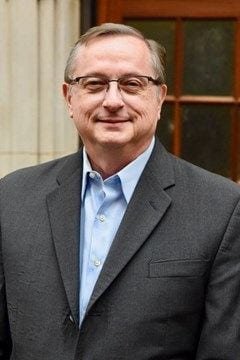 Dr. Karl Schubert, mentor, U of A Data Science Professor (COE, WCOB, ARSC) Dr. Karl Schubert, mentor, U of A Data Science Professor (COE, WCOB, ARSC) |
“The Alpha Research Program is an outstanding student-conceived, student-led, student-managed, and student-driven initiative. The students participating in the program have an opportunity to pursue areas of research and innovation that are meaningful to their career goals and the betterment of society. And, thanks to the recruitment of faculty mentors, the students also have a unique opportunity to actually be mentored on their own research by an expert in their field… I am fortunate to be mentoring an outstanding student team who is focused on the parallel to ‘food insecurity’: ‘medical care insecurity’ which they have called ‘HealthcARe for All.’ Their project has the potential for significantly improving the awareness of and access to healthcare to those in our community (locally, regionally, and statewide) and to, as a result, improve the health of many children and adults. I am honored to have the opportunity to provide advice and counsel to this team!” |
Information link to attach: https://drive.google.com/file/d/1XvBXmlZrPeLCqIHO94BjsmjBhADrkWnh/view?usp=sharing
 300,000 people are diagnosed with a brain tumor in the United States every year, and it takes up to six weeks to confirm a diagnosis after receiving a tumor biopsy. This time delay is largely due to the World Health Organization guidelines, which recommends genetic sequencing as part of standard diagnosis. As a result, tumor samples are sent to an external sequencing company, resulting in a prolonged and distressing wait for patients and their families. CiphrX provides a solution that enables same-day genetic sequencing to be performed within the hospital, ultimately accelerating the initiation of treatment and enabling enrollment into potentially lifesaving clinical trials. We leverage a third-party Oxford Nanopore sequencing device and our product consists of a patent-pending sample preparation kit that enables rapid sample preparation using a CRISPR-based enrichment approach. Additionally, CiphrX provides a proprietary software platform that analyzes the data and produces a user-friendly report to guide clinical decision-making. I was drawn to this idea early on because of its relevance to my own research in the lab of Dr. Chris Nelson (Department of Biomedical Engineering), exploring the application of Oxford Nanopore sequencing to characterize the precision and efficacy of CRISPR-Cas9 gene editing.
300,000 people are diagnosed with a brain tumor in the United States every year, and it takes up to six weeks to confirm a diagnosis after receiving a tumor biopsy. This time delay is largely due to the World Health Organization guidelines, which recommends genetic sequencing as part of standard diagnosis. As a result, tumor samples are sent to an external sequencing company, resulting in a prolonged and distressing wait for patients and their families. CiphrX provides a solution that enables same-day genetic sequencing to be performed within the hospital, ultimately accelerating the initiation of treatment and enabling enrollment into potentially lifesaving clinical trials. We leverage a third-party Oxford Nanopore sequencing device and our product consists of a patent-pending sample preparation kit that enables rapid sample preparation using a CRISPR-based enrichment approach. Additionally, CiphrX provides a proprietary software platform that analyzes the data and produces a user-friendly report to guide clinical decision-making. I was drawn to this idea early on because of its relevance to my own research in the lab of Dr. Chris Nelson (Department of Biomedical Engineering), exploring the application of Oxford Nanopore sequencing to characterize the precision and efficacy of CRISPR-Cas9 gene editing.















